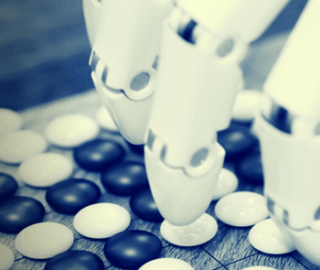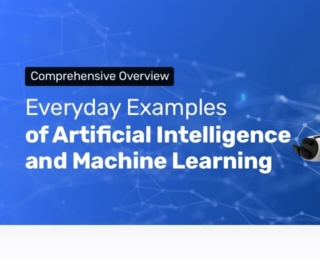
The Internet of Things (IoT) has the potential to fall into the general pit of buzzword-vagueness. Artificial intelligence (AI) often falls into the same trap, particularly with the advent of new terms such as “machine learning,” “deep learning,” “genetic algorithms,” and more.
The purpose of this article is to flesh out the actual applications of combining AI and IoT being used in industry today, and to demonstrate important trends and future use cases for technologists who want get a lay-of-the-land of how artificial intelligence might help to facilitate and make sense of the myriad connected devices in the coming decade. This article has been written with the professional or executive in mind, rather than the researcher.
Dozens of our interviews with emerging technology executives and researchers and hours of combing the insights of major market research firms (which I’ve compiled conveniently at the end of this article) seems to point to one over-arching theme in the connection of artificial intelligence and the internet of things, namely:
Artificial intelligence will be functionally necessary to wield the vast number of connected “things” online, and will be even more important in making sense of an almost endless sea of data streamed in from these devices.
So that does this mean to you as an executive, IT person, manufacturer, or anyone else with a vested interest in staying ahead of technology trends?
That’s what we’ll be exploring below. This article is broken down into three parts:
- Real-world use cases of artificial intelligence combining with the internet of things
- Potential future applications in industry and for consumers
- A brief glossary of basic AI and IoT terms, with links to credible references
The latter two sections serve as a springboard to your own further exploration of these topics, while the use cases themselves will provide the tangible grounding for how you might apply these technologies today.

Combining AI and the Internet of Things, Three Real World Use-Cases
The example applications that I’ve outlined below are all in use today, and have been chosen as representative examples of a broader trajectory of applications. I aimed to avoid overly niche applications of IoT, (like the “connected pacifier” or the “tray that alerts you when you’re out of eggs”) or IoT applications that don’t involve AI in any form. The following AI and IoT combinations are useful examples of how these two broad concepts collide.
It’s important to note that many so-called “IoT” devices wouldn’t make this list. By the criterion we’re selecting for (connected devices that leverage artificial intelligence), a device isn’t “smart” merely by virtue of being controllable via an iPhone app. Below are some useful examples:
1 – Automated vacuum cleaners, like that of the iRobot Roomba
iRobot set the standard with it’s first commercially successful automated vacuum in 2002. Founded by MIT roboticist, the company has developed technology to help it’s puck-shaped vacuum robots to map and “remember” a home layout, adapt to different surfaces or new items, clean a room with the most efficient movement pattern, and dock itself to recharge it’s batteries.
While the artificial intelligence applications in the Roomba aren’t as celebrated as broad consumer AI advances such as Facebook’s facial recognition or Apple’s Siri, it is nonetheless the industry standard in it’s class, and a clear example of artificial intelligence “embodied” in a robot (which you can now control on your app, see Roomba’s latest promotional video for the 980 model).
2 – Smart thermostat solutions, like that of Nest Labs
Though the “smart home” hasn’t exactly revolutionized life for most of us, some companies are ardently aiming to change that – and there’s few better examples than Nest, the company acquired by Google for a reported $3.2 billion.
As an IoT device, Nest’s clean digital interface is (for many) a welcome change from the clunkier physical dial, and it’s smartphone integration allow for temperature checking and controls from anywhere. This is “IoT” in principle, but many claim that Nest’s look, feel, and interface made the device more inviting and simple to use (aided largely by the fact that Nest’s founders were influential Apple employees, involved in the development of the iPod and iPad).
In terms of artificial intelligence application, Nest’s device “learns” the regular temperature preferences of it’s users, and also adapts to the work schedule of it’s users by turning down energy use. This AI application is certainly novel, but it’s pragmatic benefit (home comfort, potentially serious reduction of energy use) and effective marketing could be said to be the biggest factors behind it’s sales success (an estimated 100,000 sales per month in January 2014).
3 – Self-driving vehicles, such as that of Tesla Motors
Cars are “things,” and insomuch as we’re interested in “things” that leverage powerful artificial intelligence, automotive technology is ahead of the curve (pun intended, I suppose). This isn’t necessarily because autonomous vehicles will be the easiest IoT innovation to bring to life (with legal and ethical concerns, the jury is out on how long it’ll take to have driverless highways anytime soon), but with nearly all major car manufacturers throwing billions of dollars at the problem, it certainly has momentum (pun intended, I suppose).
To use Tesla’s technology as an example, we’ll need to understand how Tesla’s autonomous vehicle technology really works. An article in Fortune refers to Tesla CEO Elon Musk’s response to the question of what makes Tesla’s self-driving cards unique: “The whole Tesla fleet operates as a network. When one car learns something, they all learn it. That is beyond what other car companies are doing…”
Interestingly enough, Google’s self-driving approach isn’t all that different, and employs machine learning (and many hundreds of thousands of road-miles of test data) to predict the behavior of cars and pedestrians in various circumstances.
Potential Future Uses for AI-Powered IoT Devices
Today’s IoT applications are useful in understanding trends, as they lay out areas in which “traction” is proven and directions where big-company and venture money is already moving. However, autos and vacuums account for the tip of proverbial iceberg of potential IoT+ AI applications:
1 – Security and access devices
In terms of purely IoT applications, companies like ACT (Access Control Technologies) are already furthering the use of key fob technologies for unlocking doors and uses of equipment. Even in organizations with well under a thousand employees, artificial intelligence could be used to determine regular access patterns of different employees or roles and tiers of employees – providing insight for future office layouts, and potentially detecting suspicious activity (using the same kind of technology that modern cybersecurity uses in detecting outliers).
Though we weren’t able to find key fob / access key technologies integrating artificial intelligence or predictive analytics, we would suppose that as fob technology and adoption improve, this area may be rife with security insight (particularly for larger firms assessing data across many locations).
2 – Emotional analysis, facial recognition
Facial recognition has made some massive leaps and bounds in the last five years alone, and from surveillance to marketing, it seems safe to say that it’s applications haven’t been tapped. Companies like Kairos are honed in on marketing applications already, brandishing marquee clients like Nike and IMB on their homepage.
With a camera on nearly every computer and smartphone made today, gleaning information from consumer reactions to products and marketing has probably never been easier. Facebook’s auto-tagging is an example that most people will be familiar with – and other business models and uses are still to be fleshed out. The Washington Post (among other publications) has written about the potential social and ethical implications of ubiquitous facial recognition technology.
For a more detailed understanding of artificial intelligence applied to machine vision, listen to our machine vision interview with Dr. Irfan Essa of Georgia Tech.
3 – Others
I’ve compiled a few useful articles for insight into other potential combinations of IoT and AI:
- Harvard Business Review: How Smart Connected Products are Transforming Competition
- The Next Web: 2016 IoT Predictions
- NextGov 2016 IoT Predictions
AI and IoT, a Useful Glossary of Terms
With a basic understand of use-cases, trends, and predictions at the intersection of AI and the internet of things, it’ll help to understand the “lingo” (for your own further research, and in discussing these concepts to friends or colleagues). Bear in mind that “IoT” and “AI” are sometimes considered too broad to be nailed down as distinct “fields,” but rather might be considered technology “concepts.” We provide broad definitions (and related links) below:
Internet of things: Network of physical objects that contain embedded technology to communicate and sense or interact with their internal states or the external environment (Gartner)
Artificial intelligence: an area of computer science that deals with giving machines the ability to seem like they have human intelligence (Merriam Webster)
The famed John McCarthy (Stanford professors and argued to have originally dubbed the term “artificial intelligence”) has articulated some of the difficulties of defining “artificial intelligence” in this 2007 interview.
Machine learning: a method of data analysis that automates analytical model building. Using algorithms that iteratively learn from data, machine learning allows computers to find hidden insights without being explicitly programmed where to look (SAS)
Deep learning: a branch of machine learning based on a set of algorithms that attempt to model high-level abstractions in data by using multiple processing layers with complex structures, or otherwise composed of multiple non-linear transformations (Wikipedia)
Ambient intelligence: refers to electronic environments that are sensitive and responsive to the presence of people … In an ambient intelligence world, devices work in concert to support people in carrying out their everyday life activities, tasks and rituals in an easy, natural way using information and intelligence that is hidden in the network connecting these devices (Wikipedia)
Smart objects: an object that enhances the interaction with not only people but also with other Smart Objects. It can not only refer to interaction with physical world objects but also to interaction with virtual (computing environment) objects (Wikipedia)






